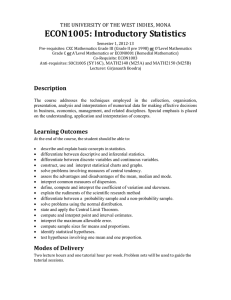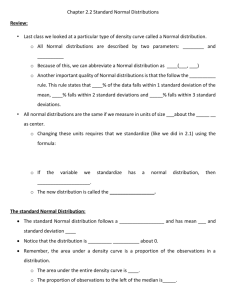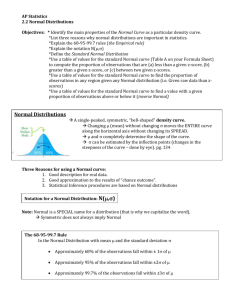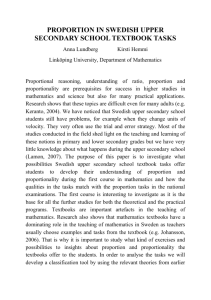M3 U1 Family Letter
advertisement
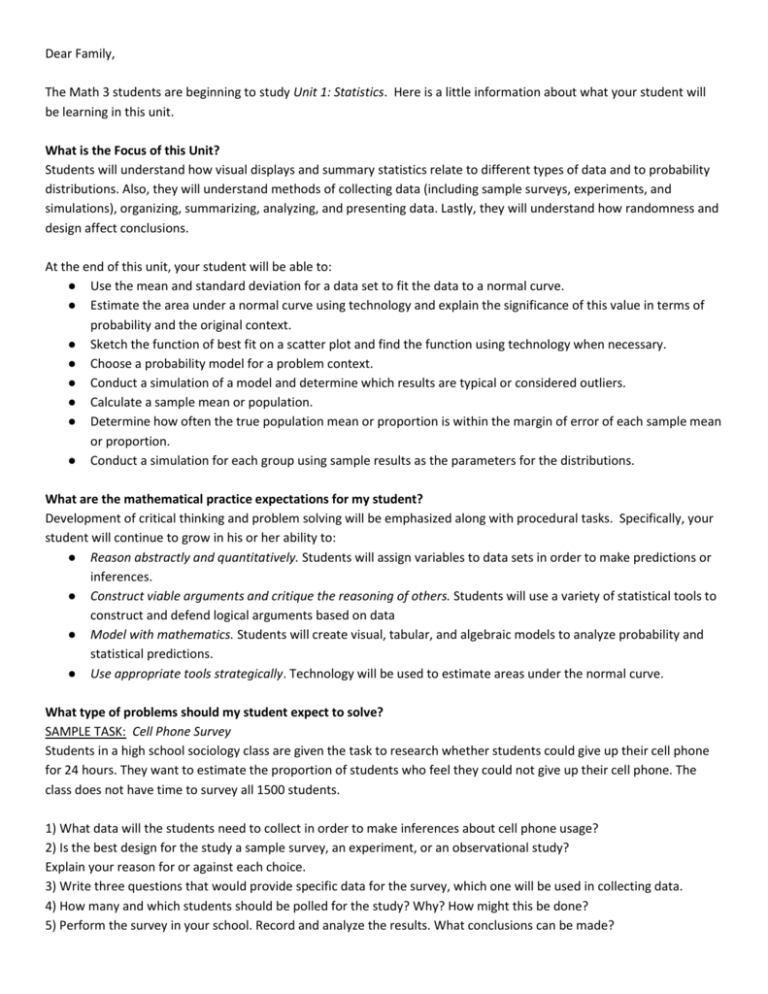
Dear Family, The Math 3 students are beginning to study Unit 1: Statistics. Here is a little information about what your student will be learning in this unit. What is the Focus of this Unit? Students will understand how visual displays and summary statistics relate to different types of data and to probability distributions. Also, they will understand methods of collecting data (including sample surveys, experiments, and simulations), organizing, summarizing, analyzing, and presenting data. Lastly, they will understand how randomness and design affect conclusions. At the end of this unit, your student will be able to: ● Use the mean and standard deviation for a data set to fit the data to a normal curve. ● Estimate the area under a normal curve using technology and explain the significance of this value in terms of probability and the original context. ● Sketch the function of best fit on a scatter plot and find the function using technology when necessary. ● Choose a probability model for a problem context. ● Conduct a simulation of a model and determine which results are typical or considered outliers. ● Calculate a sample mean or population. ● Determine how often the true population mean or proportion is within the margin of error of each sample mean or proportion. ● Conduct a simulation for each group using sample results as the parameters for the distributions. What are the mathematical practice expectations for my student? Development of critical thinking and problem solving will be emphasized along with procedural tasks. Specifically, your student will continue to grow in his or her ability to: ● Reason abstractly and quantitatively. Students will assign variables to data sets in order to make predictions or inferences. ● Construct viable arguments and critique the reasoning of others. Students will use a variety of statistical tools to construct and defend logical arguments based on data ● Model with mathematics. Students will create visual, tabular, and algebraic models to analyze probability and statistical predictions. ● Use appropriate tools strategically. Technology will be used to estimate areas under the normal curve. What type of problems should my student expect to solve? SAMPLE TASK: Cell Phone Survey Students in a high school sociology class are given the task to research whether students could give up their cell phone for 24 hours. They want to estimate the proportion of students who feel they could not give up their cell phone. The class does not have time to survey all 1500 students. 1) What data will the students need to collect in order to make inferences about cell phone usage? 2) Is the best design for the study a sample survey, an experiment, or an observational study? Explain your reason for or against each choice. 3) Write three questions that would provide specific data for the survey, which one will be used in collecting data. 4) How many and which students should be polled for the study? Why? How might this be done? 5) Perform the survey in your school. Record and analyze the results. What conclusions can be made? How would you interpret the results to make inferences about the general population? 6) How might the survey’s results change if a different question from part 3 were used? Adapted from http://s3.amazonaws.com/illustrativemathematics/illustration_pdfs/000/000/122/original/illustrative_mathematics_12 2.pdf?1343857428 How will my student apply what he/she learns in the future? Students will use probabilities to make fair decisions and analyze others’ decisions using probability concepts. Some non-mathematics college majors that require knowledge of statistics include the sciences, social sciences, business, and engineering. Some careers that use knowledge based on the skills in this unit are an actuary, manufacturing technician, industrial engineer, statistician, and production manager. Students will also be better problem solvers and critical thinkers, with technological skills that apply to multiple disciplines. How can I help my student at home? ● Ask your student to explain uses of vocabulary terms from this unit: inference, population parameter, random sample, statistics, randomization, population mean, sample mean, margin of error, confidence interval, standard deviation, bias ● Ask your student to describe a current event that might be better understood using data collection and analysis. How might the data be collected? ● Encourage your student to be persistent; make sure that he or she knows that mathematics requires patience, practice, and time to think and reflect.* ● Show interest for your student’s study of mathematics. Ask your student to explain solutions to problems. While correct answers are important, being able to explain reasoning is equally important.* ● Urge your student to ask the teacher questions either during or outside of class.* ● Encourage your student to review class notes frequently.* ● When your student doesn’t understand, a possible suggestion you can provide is to work backwards to determine how the solution was found.* ● Contact your student’s teacher for resources to support your student. *adapted from Council of the Great City Schools. (2014). Parent Roadmap: Supporting your child in high school mathematics. Retrieved from http://www.cgcs.org/cms/lib/DC00001581/Centricity/Domain/36/ParentGuide_Math_HS_Final.pdf








